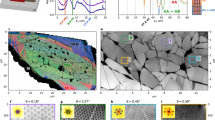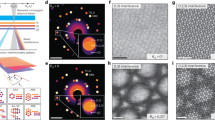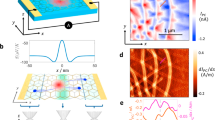Abstract
Van der Waals heteroepitaxy allows deterministic control over lattice mismatch or azimuthal orientation between atomic layers to produce long-wavelength superlattices. The resulting electronic phases depend critically on the superlattice periodicity and localized structural deformations that introduce disorder and strain. In this study we used Bragg interferometry to capture atomic displacement fields in twisted bilayer graphene with twist angles <2°. Nanoscale spatial fluctuations in twist angle and uniaxial heterostrain were statistically evaluated, revealing the prevalence of short-range disorder in moiré heterostructures. By quantitatively mapping strain tensor fields, we uncovered two regimes of structural relaxation and disentangled the electronic contributions of constituent rotation modes. Further, we found that applied heterostrain accumulates anisotropically in saddle-point regions, generating distinctive striped strain phases. Our results establish the reconstruction mechanics underpinning the twist-angle-dependent electronic behaviour of twisted bilayer graphene and provide a framework for directly visualizing structural relaxation, disorder and strain in moiré materials.
This is a preview of subscription content, access via your institution
Access options
Access Nature and 54 other Nature Portfolio journals
Get Nature+, our best-value online-access subscription
$29.99 / 30 days
cancel any time
Subscribe to this journal
Receive 12 print issues and online access
$259.00 per year
only $21.58 per issue
Buy this article
- Purchase on Springer Link
- Instant access to full article PDF
Prices may be subject to local taxes which are calculated during checkout






Similar content being viewed by others
Data availability
The datasets generated and/or analysed during the current study have been made publicly available from the Zenodo repository. Digital object identifiers (DOIs) to these datasets are provided in refs. 12–30 of the Supplementary Information. Additional information on these datasets and the manuscript figures to which each dataset corresponds are detailed in Supplementary Table 4.
Code availability
The computer code used for the dataset processing and strain analysis has been made publicly available at https://github.com/bediakolab/StrainFieldsInTwistedBilayerGraphene.
References
Balents, L., Dean, C. R., Efetov, D. K. & Young, A. F. Superconductivity and strong correlations in moiré flat bands. Nat. Phys. 16, 725–733 (2020).
Yankowitz, M., Ma, Q., Jarillo-Herrero, P. & LeRoy, B. J. van der Waals heterostructures combining graphene and hexagonal boron nitride. Nat. Rev. Phys. 1, 112–125 (2019).
Bistritzer, R. & MacDonald, A. H. Moiré bands in twisted double-layer graphene. Proc. Natl Acad. Sci. USA 108, 12233–12237 (2011).
Yankowitz, M. et al. Emergence of superlattice Dirac points in graphene on hexagonal boron nitride. Nat. Phys. 8, 382–386 (2012).
Cao, Y. et al. Unconventional superconductivity in magic-angle graphene superlattices. Nature 556, 43–50 (2018).
Yankowitz, M. et al. Tuning superconductivity in twisted bilayer graphene. Science 363, 1059–1064 (2019).
Lu, X. et al. Superconductors, orbital magnets and correlated states in magic-angle bilayer graphene. Nature 574, 653–657 (2019).
Sharpe, A. L. et al. Emergent ferromagnetism near three-quarters filling in twisted bilayer graphene. Science 365, 605–608 (2019).
Seyler, K. L. et al. Signatures of moiré-trapped valley excitons in MoSe2/WSe2 heterobilayers. Nature 567, 66–70 (2019).
Tran, K. et al. Evidence for moiré excitons in van der Waals heterostructures. Nature 567, 71–75 (2019).
Jin, C. et al. Observation of moiré excitons in WSe2/WS2 heterostructure superlattices. Nature 567, 76–80 (2019).
Wang, L. et al. Correlated electronic phases in twisted bilayer transition metal dichalcogenides. Nat. Mater. 19, 861–866 (2020).
Woods, C. R. et al. Commensurate–incommensurate transition in graphene on hexagonal boron nitride. Nat. Phys. 10, 451–456 (2014).
van Wijk, M. M., Schuring, A., Katsnelson, M. I. & Fasolino, A. Relaxation of moiré patterns for slightly misaligned identical lattices: graphene on graphite. 2D Mater. 2, 034010 (2015).
Dai, S., Xiang, Y. & Srolovitz, D. J. Twisted bilayer graphene: moiré with a twist. Nano Lett. 16, 5923–5927 (2016).
Jain, S. K., Juričić, V. & Barkema, G. T. Structure of twisted and buckled bilayer graphene. 2D Mater. 4, 015018 (2016).
Nam, N. N. T. & Koshino, M. Lattice relaxation and energy band modulation in twisted bilayer graphene. Phys. Rev. B 96, 075311 (2017).
Zhang, K. & Tadmor, E. B. Structural and electron diffraction scaling of twisted graphene bilayers. J. Mech. Phys. Solids 112, 225–238 (2018).
Yoo, H. et al. Atomic and electronic reconstruction at the van der Waals interface in twisted bilayer graphene. Nat. Mater. 18, 448–453 (2019).
Rosenberger, M. R. et al. Twist angle-dependent atomic reconstruction and moiré patterns in transition metal dichalcogenide heterostructures. ACS Nano 14, 4550–4558 (2020).
Weston, A. et al. Atomic reconstruction in twisted bilayers of transition metal dichalcogenides. Nat. Nanotechnol. 15, 592–597 (2020).
Alden, J. S. et al. Strain solitons and topological defects in bilayer graphene. Proc. Natl Acad. Sci. USA 110, 11256–11260 (2013).
Uri, A. et al. Mapping the twist-angle disorder and Landau levels in magic-angle graphene. Nature 581, 47–52 (2020).
Wilson, J. H., Fu, Y., Das Sarma, S. & Pixley, J. H. Disorder in twisted bilayer graphene. Phys. Rev. Res. 2, 023325 (2020).
Kerelsky, A. et al. Maximized electron interactions at the magic angle in twisted bilayer graphene. Nature 572, 95–100 (2019).
Huder, L. et al. Electronic spectrum of twisted graphene layers under heterostrain. Phys. Rev. Lett. 120, 156405 (2018).
Bi, Z., Yuan, N. F. Q. & Fu, L. Designing flat bands by strain. Phys. Rev. B 100, 035448 (2019).
McGilly, L. J. et al. Visualization of moiré superlattices. Nat. Nanotechnol. 15, 580–584 (2020).
Han, Y. et al. Strain mapping of two-dimensional heterostructures with subpicometer precision. Nano Lett. 18, 3746–3751 (2018).
Yang, H. et al. 4D STEM: high efficiency phase contrast imaging using a fast pixelated detector. J. Phys. Conf. Ser. 644, 012032 (2015).
Jiang, Y. et al. Electron ptychography of 2D materials to deep sub-ångström resolution. Nature 559, 343–349 (2018).
Ophus, C. Four-dimensional scanning transmission electron microscopy (4D-STEM): from scanning nanodiffraction to ptychography and beyond. Microsc. Microanal. 25, 563–582 (2019).
Kim, K. et al. van der Waals heterostructures with high accuracy rotational alignment. Nano Lett. 16, 1989–1995 (2016).
Ozdol, V. B. et al. Strain mapping at nanometer resolution using advanced nano-beam electron diffraction. Appl. Phys. Lett. 106, 253107 (2015).
Kelly, P. Solid Mechanics Lecture Notes (Univ. of Auckland, 2013).
McGinty, B. Continuum Mechanics (2012); https://www.continuummechanics.org
Butz, B. et al. Dislocations in bilayer graphene. Nature 505, 533–537 (2014).
Fang, S. & Kaxiras, E. Electronic structure theory of weakly interacting bilayers. Phys. Rev. B 93, 235153 (2016).
Carr, S., Fang, S., Zhu, Z. & Kaxiras, E. Exact continuum model for low energy electronic states of twisted bilayer graphene. Phys. Rev. Res. 1, 013001 (2019).
Guinea, F. & Walet, N. R. Continuum models for twisted bilayer graphene: effect of lattice deformation and hopping parameters. Phys. Rev. B 99, 205134 (2019).
Latychevskaia, T. et al. Holographic reconstruction of interlayer distance of bilayer two-dimensional crystal samples from their convergent beam electron diffraction patterns. Ultramicroscopy 219, 113021 (2020).
Cao, Y. et al. Superlattice-induced insulating states and valley-protected orbits in twisted bilayer graphene. Phys. Rev. Lett. 117, 116804 (2016).
Boresi, A. P. & Schmidt, R. J. in Advanced Mechanics of Materials 55–72 (Wiley, 2003).
Metcalf, T. R. Resolving the 180-degree ambiguity in vector magnetic field measurements: the ‘minimum’ energy solution. Sol. Phys. 155, 235–242 (1994).
Lu, W. et al. Implementation of higher-order variational models made easy for image processing. Math. Methods Appl. Sci. 39, 4208–4233 (2016).
Duan, J. et al. An edge-weighted second order variational model for image decomposition. Digit. Signal Process. 49, 162–181 (2016).
Savitzky, B. et al. py4DSTEM: a software package for multimodal analysis of four-dimensional scanning transmission electron microscopy datasets. Preprint at https://arxiv.org/abs/2003.09523 (2020).
Ophus, C., Ciston, J. & Nelson, C. T. Correcting nonlinear drift distortion of scanning probe and scanning transmission electron microscopies from image pairs with orthogonal scan directions. Ultramicroscopy 162, 1–9 (2016).
Acknowledgements
We thank P. Kim for discussions. The major experimental work was supported by the Office of Naval Research Young Investigator Program under award no. N00014-19-1-2199 (D.K.B.). M.V.W. acknowledges support from an NSF GRFP award and a UC Berkeley Chancellor’s Fellowship. Work at the Molecular Foundry was supported by the Office of Science, Office of Basic Energy Sciences, of the US Department of Energy under contract no. DE-AC02-05CH1123. C.O. acknowledges the support of the Department of Energy Early Career Research Award programme. S.C. acknowledges support from the NSF through grant no. OIA-1921199. J.C. and H.G.B. acknowledge support from the Presidential Early Career Award for Scientists and Engineers (PECASE) through the US Department of Energy. D.K.B. acknowledges support from the Rose Hills Foundation through the Rose Hills Innovator Program. K.W. and T.T. acknowledge support from the Elemental Strategy Initiative conducted by the MEXT, Japan, grant no. JPMXP0112101001, JSPS KAKENHI grant no. JP20H00354 and the CREST (JPMJCR15F3), JST.
Author information
Authors and Affiliations
Contributions
N.P.K., M.V.W., C.O., K.C.B., H.G.B. and D.K.B. conceived the study. M.V.W. designed and fabricated the samples. M.V.W., K.C.B. and J.C. acquired the 4D-STEM data. N.P.K., C.O. and H.G.B. created the data analysis code. S.C. carried out the band structure calculations and finite-element modelling. T.T. and K.W. provided the bulk hBN crystals. N.P.K. and M.V.W. processed the data. N.P.K., M.V.W. and D.K.B. analysed the data and wrote the manuscript. All the authors contributed to the overall scientific interpretation and edited the manuscript.
Corresponding author
Ethics declarations
Competing interests
The authors declare no competing interests.
Additional information
Peer review information Nature Materials thanks Jeil Jung, Jannik Meyer and the other, anonymous, reviewer(s) for their contribution to the peer review of this work.
Publisher’s note Springer Nature remains neutral with regard to jurisdictional claims in published maps and institutional affiliations.
Supplementary information
Supplementary Information
Supplementary Sections 1–12, Figs. 1–28 and Tables 1–3.
Supplementary Table 4
Details of all relevant 4D-STEM datasets (uploaded to Zenodo repository) corresponding to refs. 12–30 of the Supplementary Informaton.
Rights and permissions
About this article
Cite this article
Kazmierczak, N.P., Van Winkle, M., Ophus, C. et al. Strain fields in twisted bilayer graphene. Nat. Mater. 20, 956–963 (2021). https://doi.org/10.1038/s41563-021-00973-w
Received:
Accepted:
Published:
Issue Date:
DOI: https://doi.org/10.1038/s41563-021-00973-w
This article is cited by
-
Local atomic stacking and symmetry in twisted graphene trilayers
Nature Materials (2024)
-
Engineering interfacial polarization switching in van der Waals multilayers
Nature Nanotechnology (2024)
-
Unveiling the intricate moiré of moiré texture
Nature Materials (2024)
-
Three-dimensional nonlinear optical materials from twisted two-dimensional van der Waals interfaces
Nature Photonics (2024)
-
A 2D ferroelectric vortex pattern in twisted BaTiO3 freestanding layers
Nature (2024)



